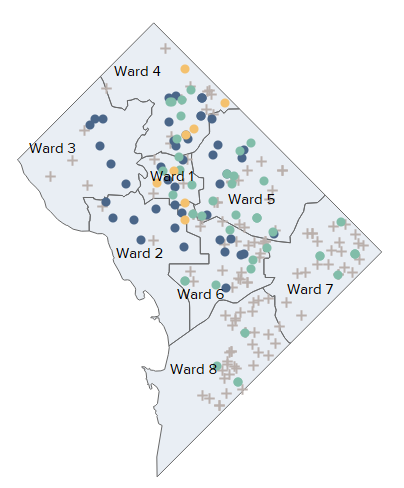FOR IMMEDIATE RELEASE
Analysis of Diversity in D.C. Schools Finds Little Overlap Between Racial and Economic Diversity
New data shows a diversifying Washington region, but diversity is hard to find school by school in the District of Columbia. A new report, “Landscape of Diversity in D.C. Public Schools”, by D.C. Policy Center finds that only eight traditional public or public charter schools in D.C. lead in both racial and economic diversity.
WASHINGTON, D.C., December 17, 2018—Shifting demographics in the District of Columbia are changing the racial, ethnic, and economic composition of traditional public and public charter school students. However, increased diversity of the overall student body is not always reflected at the school level. A new report from the D.C. Policy Center finds that many schools in D.C. still have extremely high concentrations of students from a single ethnic, racial, or income group.
This report provides a snapshot of diversity in D.C.’s public schools more than 60 years after D.C.’s court-ordered desegregation, at a time when enrollment in the city’s public schools is growing and the demographics of the student body are changing. The analysis identifies the group with the highest proportion of students at each school and calculates a diversity score based on the sum of all other groups. This gives a sense of the extent to which groups are represented, increasing the potential for interaction between groups.
The report finds that racial and ethnic diversity is low in D.C. schools, even considering the demographic composition of students attending public schools. Students are more concentrated by race and ethnicity than economic status. In 2016-17 (the most recent year of data at time of analysis), 68 percent of students were African American, 18 percent were Latino, and 10 percent were white. However, in that same year, half of D.C.’s public schools had a student body that was at least 90 percent African American, meaning that many students did not attend school with a substantial number of students from other racial or ethnic groups. By comparison, at more than half of schools, the share of low-income students (which the study proxies through at-risk students) is between 40 and 60 percent.
Diverse schools have been shown to improve outcomes for students of all backgrounds, particularly students of color and low-income students.
“Elsie Whitlow Stokes Community Freedom PCS is an example of one of the most racially and ethnically diverse schools in D.C. We leverage this diversity to prepare students who are committed to social justice and can communicate in at least two languages,” said Erika Bryant, the school’s executive director.
There is little overlap between racial and economic diversity at a majority of D.C. schools. Overall, there is a lack of economic diversity in schools in Wards 2 and 3 and a lack of racial and ethnic diversity in Wards 7 and 8. Only eight out of 209 schools are the most diverse in both categories:
- EL Haynes PCS High School
- Barnard ES
- LaSalle Backus EC
- Tubman ES
- Center City PCS Shaw
- H D Cooke ES
- Takoma EC
- Cleveland ES
None of these schools has a majority of white students, and only one is a high school. These schools are geographically concentrated; all but one is located in Ward 1 or 4.
For the majority of schools, the level of diversity is “sticky” and did not change from 2014-15 to 2016-17, but some schools experienced large shifts. When such changes did occur, schools located east of the Anacostia River mostly became more economically diverse, and schools located west of Rock Creek Park mostly became more racially and ethnically diverse. A few schools switched their largest racial or ethnic group entirely: out of 194 schools, 10 changed their plurality race or ethnicity and 13 changed their plurality economic group.
“The impact of a diverse student body on student learning, positive self-identity and equitable opportunity is complex and merits significant attention from researchers and school systems. The presence of students from different backgrounds in a school building creates the opportunity for all engaged in that school community – staff, families, students and community partners – to grapple collectively with the systemic and interpersonal influences that continue to perpetuate inequity, but only if intentional dialogue is part of the school’s strategy. Diversity in the composition of the student body is only a first step toward true integration,” said Laura Wilson Phelan, executive director and founder of Kindred and representative to the State Board of Education for Ward 1.
The study highlights that the city’s schools have a long way to go in achieving racial and ethnic diversity. At the same time, economic diversity could potentially decrease as incomes in certain neighborhoods increase, resulting in a lower share of at-risk students. To maintain and increase diversity, schools that seek diversity need to focus on both race and economic status. And although attending diverse schools can have life-long impacts, a diverse student body is not sufficient to realize the benefits from diversity – the right school-level approaches that involve staff, students, and families are necessary to enable true integration.
“As D.C. continues to change, the schools that intentionally seek to serve a diverse student body will have to be thoughtful about how they get and maintain those students,” said Sonia C. Park, executive director of the Diverse Charter Schools Coalition.
“Landscape of Diversity in DC Public Schools” is the third report in the D.C. Policy Center’s education research series “Changing Schools in a Growing City.”
Read more:
To keep up with the “Changing Schools in a Growing City” series, sign up for emails from D.C. Policy Center.
